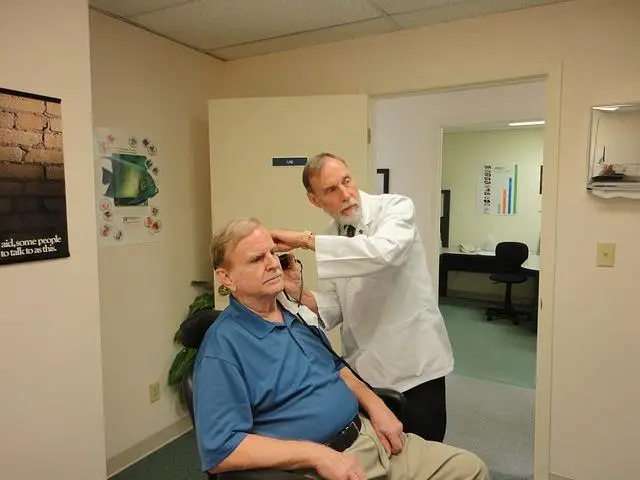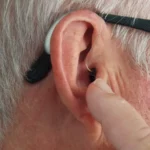Last Updated on 12 months by Francis
Contents
The Ultimate Guide to Healthy Ears

URL: https://pixabay.com/photos/hearing-aid-hearing-ears-aid-ear-1490115/
Ear health is essential to well-being and overall health. Poor ear health can affect several life aspects, like employment, well-being, and education. Untreated ear issues and hearing loss can significantly impact your quality of life. However, maintaining ear health can help protect your hearing and ensure healthy ears. Here’s the ultimate guide to healthy ears.
Familiarize yourself with common ear health issues
Understanding common ear health problems, their causes, and how to avoid them makes it easier to protect your ear health. Here are several ear ailments you should know about and safeguard against:
- Hearing loss
Hearing loss involves partial or complete incapability to hear sounds. It may be caused by inner ear damage, earwax buildup, ear infection, ruptured eardrum, age, constant exposure to loud noises, and tumors or unusual bone growths. It may also be caused by diseases like meningitis and medicines such as cancer treatment medications. Hearing loss can also be hereditary. There are different types of hearing loss, including sensorineural (affects the inner ear), conductive (impacts the middle or outer ear), and a combination of these two. Hearing loss can also be allergy-related.
Allergies can affect your inner, middle, and outer ear. Do allergies cause clogged ears? You may ask. When the immune system reacts to allergens, the Eustachian tube’s lining may swell, causing pressure, pain, blocked ear, and fluid buildup. Nonetheless, learning how to prevent hearing loss can help ensure healthy ears.
- Ear infections
Ear infections can be viral or bacterial. They affect the middle, inner, and outer ear. While ear infections often end on their own, they can be painful because of fluid buildup or inflammation. Ear infections can be acute or chronic. The chronic ones may recur several times or never clear at all, while the acute ones are short-term but painful. Bacteria or viruses cause ear infections and mostly result from your Eustachian tube’s blockage.
Colds, allergies, excess mucus, sinus infections, air pressure changes, and smoking may cause the blockage. You can reduce or prevent ear infection risks in yourself and your child by avoiding smoking, controlling allergies, preventing colds, breastfeeding your young one, and getting vaccinations.
- Tinnitus
Over 50 million Americans, or 15% of them, experience tinnitus. This makes it a reason for concern. Tinnitus or ringing in the ears involves experiencing buzzing, ringing, hissing, whistling, chirping, and other sounds. Prolonged loud sound exposure is the primary tinnitus cause. Severe tinnitus may help people to experience sleeping and concentrating difficulties.
Ear blockages from wax buildup or an ear infection, the natural aging process, specific drugs, allergies, Otosclerosis, jaw or neck problems, head and neck injuries, and Meniere’s disease. Safeguarding your hearing is the best way to prevent tinnitus. Wear earplugs if you work in landscaping, around loud machinery, or in construction. You can also wear earplugs at gyms that play loud music, movie theaters, and concerts.
- Vertigo
Vertigo is a feeling that the surroundings around you are spinning. It may make you feel off-balance and dizzy. While vertigo is not a disease, it’s a sign of different conditions. You can have peripheral vertigo, which occurs when there’s an issue with your inner ear, or central vertigo, which happens when there’s a problem with the brain. Different conditions or syndromes may lead to vertigo, including Meniere’s disease, benign paroxysmal positional vertigo, labyrinthitis, cholesteatoma, and vestibular neuritis.
Migraine headaches, stroke, diabetes, ear surgery, head injuries, low blood pressure, ataxia, acoustic neuroma, and other factors may also lead to vertigo attacks. Physical, emotional, and chemical stressors determine how severely and often you experience these attacks. How you handle these stressors can help you prevent vertigo.
Learn how to clean your ears properly
Your ears produce earwax or cerumen to coat your ears, preventing them from flaking or drying. Additionally, the tiny hairs in your ears and the earwax usually trap all the foreign particles and dirt, preventing them from reaching the inner ear. When dirt and grime accumulate, chunky ear wax lumps form. Cerumen is self-cleaning. Your jaws move when chewing food. This movement pushes out small earwax pieces. However, if you have stubborn earwax, it will cling to your ears’ skin. If the wax continues building up, it results in cerumen impaction, eventually blocking the ear canal. This may lead to hearing issues and tinnitus.
Earwax may harden, and scraping or tugging it may result in bleeding. You can soften it first using lubricants like glycerin and baby oil, making the cerumen yield. Use cotton buds or swabs for ear cleaning the outer ear. This will scrub your skin clean or collect wax. When using the cotton swabs, don’t shove them inside your ear, as they might push earwax much deeper. Avoid plunging sharp objects like safety pins and a pen’s tip into your ears when cleaning your ears because they puncture the eardrum.
Consider professional earwax removal
Earwax buildup or excess earwax should be a concern because it can cause discomfort, pain, and trouble hearing. While you can remove the earwax yourself, doing so might push the wax further in and even damage delicate inner ear parts. If you’re experiencing discomfort, ear pain, itchy ears, fullness, hearing loss, tinnitus, or discharge from your ear canal, it could be time to seek professional earwax removal services.
Professional earwax removal would be an ideal option because it’s effective, safe, and done by an expert. The earwax removal expert can use suction, a curette, or forceps (manual method) to remove the excess earwax safely. They can also use irrigation methods to extract the wax.
Schedule regular hearing tests
Hearing loss develops gradually over time. This makes it hard to notice changes in your hearing and ear health. Early intervention is crucial to maintaining ear health and healthy hearing. This is where regular ear check ups come in. They help identify hearing issues in advance, easing their management and ensuring better medication response. They also prevent hearing loss. Hearing screening can help spot underlying medical problems like earwax buildup and ear infections that may affect your ear health. Here are the various types of hearing tests you can get:
- Pure tone testing
Also called pure tone audiometry, pure tone testing utilizes air conduction to track your capacity to hear sounds at varying volumes and pitches.
- Speech testing
Speech testing measures your SRT (speech reception threshold) or unclear speech you may understand half the time. It’s administered in a noisy or quiet environment and tracks your capability to distinguish speech from background noises.
- Bone conduction testing
Bone conduction testing is a kind of pure tone test that determines the inner ear’s sound response. If this test’s results vary from the pure tone test, your audiologist may use these details to identify your hearing loss type.
- Tympanometry
The tympanometry test measures your eardrum’s movement in air pressure response. It can determine whether there’s a fluid buildup, earwax buildup, tumors, or eardrum perforations.
- Auditory brainstem response (ABR)
ABR testing determines if a particular hearing loss, including sensorineural, exists. Also, it’s used for newborn screening for hearing issues. The test measures brain activity in response to varying sound intensities.
- Acoustic reflex testing
Acoustic reflex testing measures the middle ear’s uncontrolled muscle contractions and determines where your hearing problem is and the kind of hearing loss.
- Otoacoustic emissions
Otoacoustic emissions are sounds created by hair cell vibrations in your inner ear’s cochlea. This testing utilizes a small probe fitted with a speaker and microphone to prompt the cochlea and track its response. This test determines if there’s an ear canal blockage, cochlea hair cell damage, or excess fluid in your middle ear.
Wear ear protection devices
Long-term noise exposure significantly damages your hearing and ear health. This damage gradually worsens with every repeat exposure. However, very high sound levels, including those from explosions, fireworks, and gunfire, may lead to immediate harm. Hearing protection devices are essential to preventing noise-induced hearing loss. They reduce the sound intensity reaching your inner ear, preventing potential damage. When choosing ear protection, ensure it’s right for you.
Types of hearing protection
Here are several hearing protectors to consider when looking for one. They include:
- Expandable foam plugs: They’re made of formable materials meant to expand and accommodate the shape of every wearer’s ear canal
- Canal caps: These usually look like earplugs on flexible metal or plastic bands. A canal cap’s earplug tips can be a pre-molded or formable material. They might have headbands to wear over the head, under the chin, or behind the neck. Canal caps are convenient because you can hang them around the neck when your surroundings are quiet or put the earplugs back in immediately after hazardous noise begins
- Pre-molded, reusable plugs: These plugs are from plastic, rubber, or silicone and are manufactured in different sizes or one-size-fits-the-most. Most pre-molded plugs can be found in large, small, or medium size ear canals. These plugs must cover the ear canal but shouldn’t be uncomfortable. Pre-molded plugs are reusable, inexpensive, convenient to carry, washable, and in various sizes
- Earmuffs: Earmuffs are in several models meant to suit different users. They keep away noise by blocking the outer ear completely. The muffs may be low profile with tiny ear cups or big ones to hold additional materials for extreme noise use. Some muffs may have electronic components to assist users in blocking impulsive sounds or communication. Earmuffs may not be the best option if you have sideburns, heavy beards, or wear glasses because the glasses’ temples and hair can break the seal earmuff cushions create around your ear. In such cases, earplugs may be the best
The best hearing protectors should be suitable for the job, offer sufficient noise attenuation or protection, be compatible with other communication devices or PPE, be comfortable enough for you to wear, be capable of offering adequate audibility or communication needs, and be suitable for workplace humidity and temperature.
Start exercising
Hearing loss and exercise have a connection. Hearing loss is linked to reduced physical function, balance issues, cognitive decline, minimized well-being, and lower endurance, all of which can improve with exercise. Physical activity boosts circulation, preserving the essential capillaries that take oxygen and blood to the ear for cochlea and surrounding structure preservation. As people age, inflammation may damage their nerve cells, capillaries, and hair cells, causing your ears not to function correctly or making them not get sufficient oxygen.
Regular workouts can help boost ear health and protect against or delay age-related hearing loss. Exercise protects your body from age-related inflammation and improves cardiovascular health, keeping blood circulating all over your ears and body. Cardiovascular exercises like brisk walking, jogging, running, burpees, swimming, bear crawls, water aerobics, dancing, cycling, circuit training, hiking, mountain climbing, and more can help with ear health.
Mind your diet
Diet can impact your inner ear’s susceptibility to age and noise-related impacts that result in hearing loss and tinnitus. Focusing on foods that can boost hearing health can help ensure healthy ears. Here are several foods to consider:
- Potassium-rich foods: Potassium regulates your inner ear’s fluids which is crucial because as you age, their levels tend to reduce, contributing to presbycusis and hearing loss. Eating potassium-rich foods like tomatoes, potatoes, lima beans, spinach, raisins, bananas, yogurt, low-fat milk, apricot, oranges, and melons can be helpful
- Zinc-rich food: Zinc, known to heal wounds and boost cell growth, can improve your body’s immune system and ward against infections that may affect your ear. Beef, cashews, peanuts, almonds, lentils, split peas, beans, oysters, and others can give you adequate zinc for your ear health
- Folic acid-rich foods: Folic acid assists the body in generating new cell growth and increasing body circulation, improving your inner ear’s hair cells’ overall health. Spinach, asparagus, broccoli, liver, and fortified breakfast cereal are folic-acid-rich foods you can add to your diet
- Magnesium-rich foods: Magnesium helps fight off free radical effects emitted in loud noises, safeguarding you from noise-related hearing loss. Potatoes, brown rice, almonds, tomatoes, pumpkin seeds, broccoli, bananas, spinach, and artichokes are magnesium-rich foods you can incorporate into your diet
- Omega 3-rich foods: Omega 3s can help strengthen your ear’s sensory system. Consider adding tuna, salmon, olive oil, tofu, sardines, Brussel sprouts, trout, chia seeds, cauliflower, and walnuts to your diet
Endnote
Sound ear health is vital for good quality of life and overall health. Consulting this guide can help you keep your ears healthy.


.jpg)





